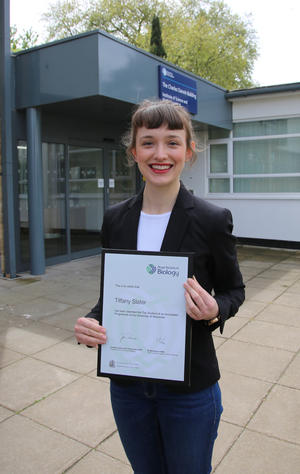A University of Worcester Biology student has won a top award from a national body for her work.

Tiffany Slater received the Top Student from an Accredited Degree award from the Royal Society of Biology at their recent Accreditation Awards Ceremony.
"I'm really pleased," said the 25-year-old.
"It really just makes me feel like the hard work paid off. Recognition makes it all worth it."
The award gives third year student Tiffany, of Birmingham, associate membership of the Royal Society of Biology, making her eligible to apply for outreach funding grants.
"You think "when can I call myself a scientist or a biologist?", said Tiffany, who is originally from Kentucky, USA, but moved to the UK for her studies.
"When it comes from the Royal Biological Society you think maybe I'm not an impostor, maybe I am a biologist. It gives you that validation."
She praised the University's role in getting her to where she is now.
"If it wasn't for the support of the University and the staff and the time they have spent with me I wouldn't have stayed as motivated and competitive as I have for the last three years," she said.
"I really enjoyed being at a university with smaller class sizes and getting the attention of the professors. Initially I went to a larger university in the States and I didn't excel there."
Tiffany, who was nominated for the award by one of her lecturers, starts a PhD in Geology in Ireland in July, at University College Cork.
She will be looking at fossil colour " the preservation of pigmentation in the fossil record.
Tiffany says pigment structures in exceptional fossils are at times preserved and these can be analysed in different ways to reconstruct colour patterns in birds and dinosaurs.
She will still be using modern biological techniques to study how fossils are made, examining the impact of bacteria and fungus on decomposition.
"I am so thrilled to be part of this new cutting-edge research," she said.
"Palaeontologists always said we'd never be able to know the colours of extinct animals. But now it's become a reality that we're getting a more accurate picture of what these creatures looked like."